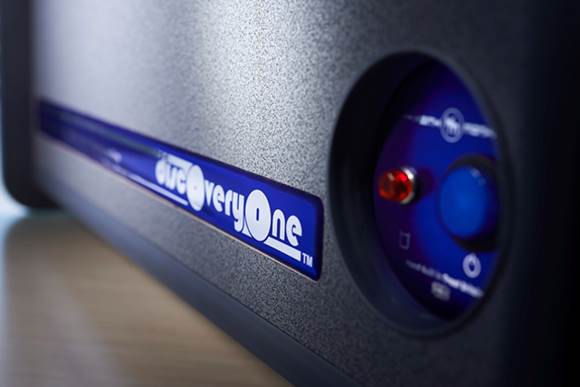There are precious few brands that have scaled the high
walls of the hi-fi industry, only to emerge blinking into the daylight of the
wider world outside. Tannoy is the obvious example – it’s even reserved itself
a place in the dictionary – and then you’re talking Linn and Quad, both of
which seem to have seeped out into some civilian circles. Keith Monks has made
that transition too – famous for that big old record cleaning machine seen in a
grimy corner of hundreds of hi-fi and record shops throughout the seventies and
eighties. It’s certainly a name to conjure with.

Keith Monks discOveryOne
record cleaning machine
Which is precisely what Jonathan Monks has done. Five years
ago he revived his father’s company and set about remaking his classic Omni
record cleaning machine. At the time, his focus was on the faithful recreation
of this legendary device – everyone who has used one knows that it works
brilliantly and Jon wasn’t willing to be told that the relaunched machine was a
shadow of the original.
All well and good. But what about those of us who merely
want to restore discs we pick up from record fairs and charity shops? And how
about vinyl junkies on a more limited budget? It is for these people that the
new discOveryOne was created.
Spring clean
It comes in two versions; the one you see here with built-in
wash system for $2,621, or for $493 less you can manually apply the cleaning
fluid. Much of the saved cost is down to the main turntable, which is no longer
a bespoke design. Instead, an adapted Technics SL-1200 clone is used. This may
seem odd, but it’s a fine piece of lateral thinking, given that there are
plenty available for relatively little money, and that these robust direct
drive designs are still strong enough to drive a cleaning machine.
Using the new discOveryOne is similar to its bigger, older
brother. You switch it on, place a dirty record on the turntable and move the
cleaning block across so it covers the whole surface of the disc. Then you
press the Mini Cooper screen washer knob and you’ll begin to see the brush –
and then the record – getting wet.

Keith Monks
discOveryOne record cleaning machine
When the disc is wet (but not drowned) with fluid, you
return the cleaning brush to its rest position and then phase two of the
operation commences. The suction arm (a converted SL-1200 clone tone arm) is
moved across to the center of the disc, and a micro switch starts up the
suction pump and pulls the arm from the inside ‘run out’ groove to the outside
‘lead in’ groove as it sucks up the fluid. This is a noticeably slower process
than with the Omni (which runs at 80rpm to the discOveryOne’s 33), but if
anything it’s easier to use. There’s auto-shut off when the suction arm
finishes its job, and I also find it slightly quieter than the original (the
noise is claimed to be 37dB, C-weighted, at 1m).

DiscOveryOne
record cleaning machine
About a minute later, you’re left with a sparkling slice of
rejuvenated vinyl. Having cleaned both sides, you’d be crazy not to put it into
a brand new polythene-lined sleeve, lest all the scunge deposited inside the
old sleeve goes straight back onto the disc surface again. Generally, I find
one clean per side sufficient – it has to be a pretty nasty disc to require a
second go. But when you do give it a second clean, it digs deeper than the
first, removing practically every trace of gunge – even deep greasy
fingermarks. I spent several months giving the original Omni a good testing,
and I’d say this new cheaper design doesn’t work any less well – it’s just
slower. I also like the automatic shut-off, when the waste container is full.
Dirty dancing
A cleaned disc plays better, regardless of how dirty it was
(or not) pre-ablutions. Obviously, if it was in a bad way, the improvement will
be dramatic, as my somewhat ‘well campaigned’ record collection shows. But even
new vinyl can benefit, not least because of the removal of the mould release
agent in the grooves. It makes for a brighter, tighter, more focused sound with
greater grip and power in the bass. That’s the great thing about having a
serious record cleaning machine such as this – as well as a basic subsistence
tool it gives you improved sound even on discs that you’d think don’t need it.
The new Keith Monks discOveryOne is an excellent product then, giving you
almost all the performance of the company’s more expensive machines, but at a
far more affordable price. Every serious record collector should have one.
|
Specifications
·
Price: $2,621
·
Tried and trusted technique from the originators of electric
record cleaning
·
Quietest ever electric record cleaner (37dB, C weighted, 1
metre)
·
Very simple and intuitive to use
·
Original Keith Monks Point Suction Precision Clean vacuum
system
·
Whisper quiet medical grade diaphragm suction pump – a compact
version of the BBC specification vacuum pump.
·
Classic Keith Monks precision wash system with Mini Cooper wash
pump (discOveryOne Classic)
·
Automatic functions including auto off
·
Engineered for long life and reliability
·
Every drop of fluid removed by powerful vacuum arm
·
Fresh, unused, uncontaminated cleaning fluid for every record
·
Fresh, unused, uncontaminated contact with machine for every
record
·
SuperSilent professional direct drive turntable
·
Automatic thread reel out
·
Dry cycle semi-automatic process
·
Auto shutdown if the waste container is full.
|